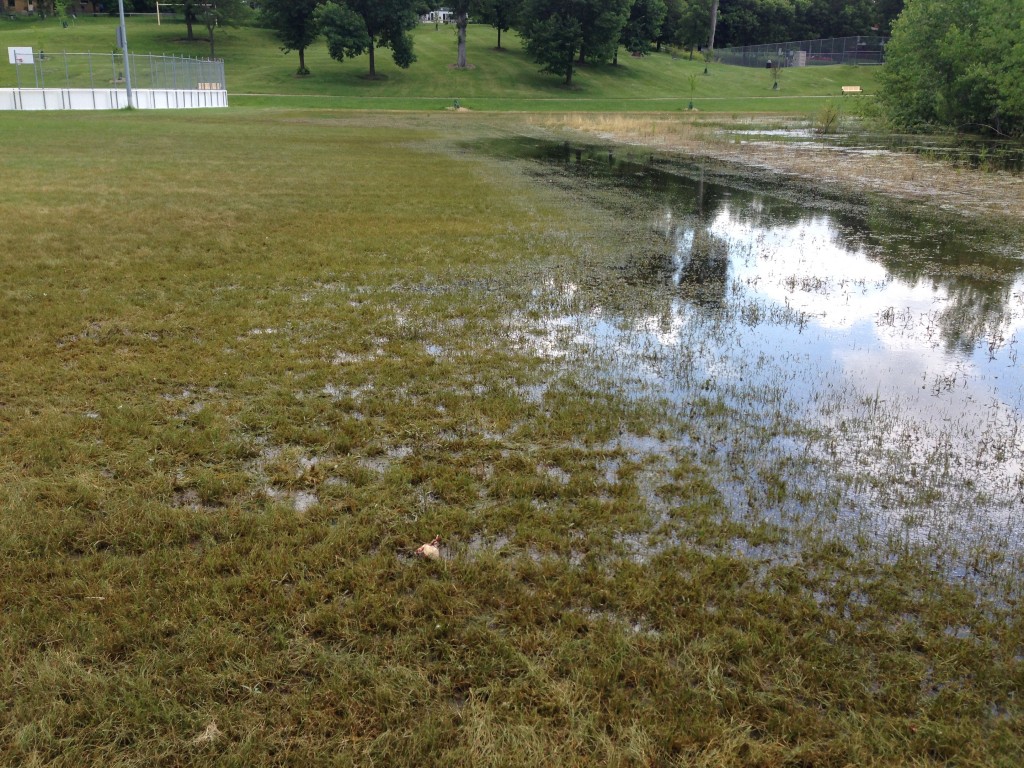By Sam Bauer
Water slowly receding from turf that will have marginal recovery. Photo: Sam Bauer
The month of June was a wet one. Many homeowners, grounds managers, and golf course superintendents are finally starting to see some of the flood waters recede, although standing water is still covering many of our landscapes. The University of Minnesota’s Climatology Working Group is calling June of 2014 the wettest month on record. In the Twin Cities we saw 11.36 inches of rain for the month, almost 7 inches above average and falling just short of the 11.67 inch record set in 1874 (www.climate.umn.edu).
We are starting to see a wide range of damage to lawns and turfgrass throughout the state. In situations where standing water was present for greater than 7-10 days, the turf is almost certainly dead and will need to be repaired. Turfgrass covered for less time has a greater chance of recovery, but every situation is different. Unfortunately, there is not good information regarding how long turfgrass can survive under standing water because there are so many potential mechanisms of damage. These mechanisms can be separated into 2 groups: primary damage from waterlogging and secondary damage after the water has gone.
Primary damage includes such factors as water temperature and water depth. Water temperature will probably be the most important factor determining survival, with turfgrass death occurring in only a few days when water temperatures are 80 degrees F and higher (note: we did not see water temperatures this high during recent floods, unless it was very shallow and stagnant). When water temperatures are lower the turf can still die, with lack of oxygen being the primary culprit. If the turf is completely submerged, this will be a worse case than if some of the leaves and crowns are exposed.
Secondary damage might be associated with sediment buildup, fungal diseases, moss and algae, and weed infestation. While we have very little control over the primary mechanisms causing damage, now is the time to start thinking about how to reduce damage that could be caused by the secondary mechanisms. The primary disease you could expect to occur after flooding is pythium blight. Look for circular or irregular patterns of dead turf inside of healthy turf areas. For more information on pythium blight, follow this link to a fact sheet from Purdue University Extension: Pythium Blight. Remember that plant disease samples can be submitted to the University of Minnesota Plant Disease Clinic for correct identification and control recommendations. If you have confirmed that you lawn is infected with pythium or other diseases, I recommend contacting a lawn care contractor to carry out the control measures.
This turf was covered with water for 8 days and will not recover. Photo: Sam Bauer
To this point I’ve been recommending that homeowners be patient and assess the damage as it presents itself. Turf that appears to be dead following the receding of flood waters should be monitored for several days; if no green tissue appears within 7-10 days, you can assume it is dead and should start forming a renovation plan. In many cases, you might be surprised with the amount of turf that recovers when the conditions are right. In situations where sediment or debris buildup has occurred, you will want to act fast to remove it. The previous Turfgrass Extension Educator, Bob Mugaas, wrote a great article addressing repair of areas where sediment has built up in the 2010 edition of the Yard and Garden News. That article can be found here: Repairing Flooded Lawns
Timing of repair can be difficult. The cool-season grasses that we grow in Minnesota do not establish well in the middle of the summer due to the high heat and diseases that may occur. If at all possible, I recommend waiting to seed until temperatures cool in the early fall around mid- to late-August. Fall seeded lawns will have a much better chance of a successful establishment. With that being said, recovery in the short term could be promoted by aerating your soil once it is dry and/or applying light rates of nitrogen based fertilizer.
Choice of turfgrass seed can be very important. If flooding is a common occurrence on your lawn, I would recommend Kentucky bluegrass over perennial ryegrass or fine fescues. The University of Minnesota Extension has numerous resources to help you in repair process. Please follow these links for more information:
Finally, feel free to reach out if we can be of help. You can contact me directly at: [email protected] or 763-767-3518

